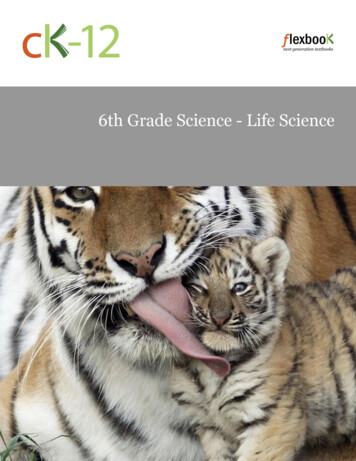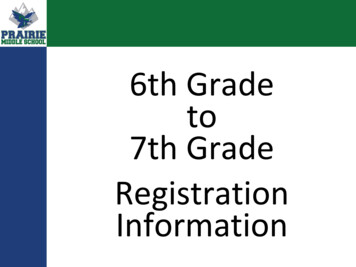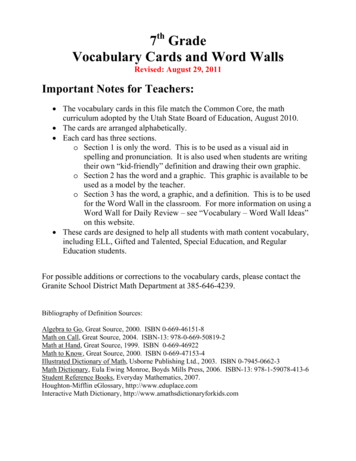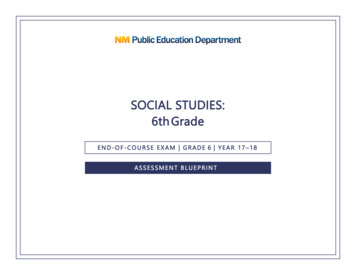
Transcription
6th grade - Life ScienceRachel WilliamsonJessica HarwoodDouglas Wilkin, Ph.D.Ken VicknairSay Thanks to the AuthorsClick http://www.ck12.org/saythanks(No sign in required)
www.ck12.orgTo access a customizable version of this book, as well as otherinteractive content, visit www.ck12.orgCK-12 Foundation is a non-profit organization with a mission toreduce the cost of textbook materials for the K-12 market both inthe U.S. and worldwide. Using an open-source, collaborative, andweb-based compilation model, CK-12 pioneers and promotes thecreation and distribution of high-quality, adaptive online textbooksthat can be mixed, modified and printed (i.e., the FlexBook textbooks).Copyright 2016 CK-12 Foundation, www.ck12.orgAUTHORSRachel WilliamsonJessica HarwoodDouglas Wilkin, Ph.D.Ken VicknairEDITORDouglas Wilkin, Ph.D.CONTRIBUTORSDoris Kraus, Ph.D.Niamh Gray-WilsonJean Brainard, Ph.D.Sarah JohnsonJane WillanCorliss KarasovThe names “CK-12” and “CK12” and associated logos and theterms “FlexBook ” and “FlexBook Platform ” (collectively“CK-12 Marks”) are trademarks and service marks of CK-12Foundation and are protected by federal, state, and internationallaws.Any form of reproduction of this book in any format or medium,in whole or in sections must include the referral attribution linkhttp://www.ck12.org/saythanks (placed in a visible location) inaddition to the following terms.Except as otherwise noted, all CK-12 Content (including CK-12Curriculum Material) is made available to Users in accordancewith the Creative Commons Attribution-Non-Commercial 3.0Unported (CC BY-NC 3.0) License (http://creativecommons.org/licenses/by-nc/3.0/), as amended and updated by Creative Commons from time to time (the “CC License”), which is incorporatedherein by this reference.Complete terms can be found at http://www.ck12.org/about/terms-of-use.Printed: June 16, 2016iii
Contentswww.ck12.orgContents1Basic and Applied Science12Characteristics of Life43Fields in the Life Sciences94Safety in the Life Sciences135Microscopes186Organization of Living Things247Light Reactions of Photosynthesis298Levels of Ecological Organization349Ecosystems3710 Food Webs4011 Energy Pyramids4312 Producers4613 Consumers and Decomposers4914 Predation5215 Invasive Species55iv
www.ck12.orgC ONCEPTConcept 1. Basic and Applied Science1Basic and Applied Science Define basic science and applied science. Distinguish between basic science and applied science.Why should we study the rainforest?Some scientists study problems that seem to have very little impact on our lives. For example, scientists are workingto describe every type of plant and animal in the rainforest. What is the purpose? Many of our medicines come fromplants and animals of the rainforest. So what medicines have not yet been discovered? There might be new cures todiseases yet to be identified. This is an example of how science can be applied to our lives.Basic and Applied ScienceScience can be "basic" or "applied." The goal of basic science is to understand how things work—whether it isa single cell, an organism made of trillions of cells, or a whole ecosystem. Scientists working on basic sciencequestions are simply looking to increase human knowledge of nature and the world around us. The knowledgeobtained through the study of the subspecialties of the life sciences is mostly basic science.Basic science is the source of most scientific theories. For example, a scientist that tries to figure out how thebody makes cholesterol, or what causes a particular disease, is performing basic science. This is also known asbasic research. Additional examples of basic research would be investigating how glucose is turned into cellularenergy or determining how elevated blood glucose levels can be harmful. The study of the cell (cell biology), thestudy of inheritance (genetics), the study of molecules (molecular biology), the study of microorganisms and viruses(microbiology and virology), the study of tissues and organs (physiology) are all types of basic research, and haveall generated lots of information that is applied to humans and human health.Applied science is using scientific discoveries, such as those from basic research, to solve practical problems. Forexample, medicine, and all that is known about how to treat patients, is applied science based on basic research1
www.ck12.org(Figure 1.1). A doctor administering a drug to lower a person’s cholesterol is an example of applied science.Applied science also creates new technologies based on basic science. For example, designing windmills to capturewind energy is applied science (Figure 1.2). This technology relies, however, on basic science. Studies of windpatterns and bird migration routes help determine the best placement for the windmills.FIGURE 1.1Surgeons operating on a person, an example of applied science.FIGURE 1.2Windmills capturing energy, an example of applied science.Summary Basic science, such as understanding how cells work, is research aimed at understanding fundamental problems. Applied science, such as the medical field, is the application of basic scientific knowledge to solve practicalproblems. Applied science uses and applies information obtained through basic science.Explore MoreUse the resources below to answer the questions that follow.2
www.ck12.orgConcept 1. Basic and Applied ScienceExplore More I Basic vs. Applied Research at ScWk170/s0/Basic-vs.-Applied-Research.pdf .1.2.3.4.What is basic research? Give two examples of basic research.What is applied research? Give two examples of applied research.What is the relationship between basic research and applied science?Why do some scientists believe more emphasis needs to be placed on applied science?Explore More II Reinvesting in Basic Research at http://www.youtube.com/watch?v NHjrMtECVo0 (3:58)MEDIAClick image to the left or use the URL below.URL: 771. How could basic biomedical research lead to better physicians?2. What is BMPER? Did its discovery come from basic or applied research? Explain your resoning fully.Review1. What is the difference between basic and applied science?2. What is an example of applied science?References1. U.S. Department of Defense. Surgeons operating on a person, an example of applied science . Public Domain2. Douglas Cataylo. Windmills capturing energy, an example of applied science . CC BY 2.03
www.ck12.orgC ONCEPT 2Characteristics of LifeDefine what it means to be living.Know the five characteristics of living organisms.Describe the five characteristics shared by all living organisms.Identify the role of the five characteristics shared by all living organisms.Summarize in detail the role of each characteristic in life.Is fire alive?Fire can grow. Fire needs fuel and oxygen. But fire is not a form of life, although it shares a few traits with someliving things. How can you distinguish between non-living and living things?The Characteristics of LifeHow do you define a living thing? What do mushrooms, daisies, cats, and bacteria have in common? All of theseare living things, or organisms. It might seem hard to think of similarities among such different organisms, but theyactually have many properties in common. Living organisms are similar to each other because all organisms evolvedfrom the same common ancestor that lived billions of years ago.All living organisms:1. Need energy to carry out life processes.2. Are composed of one or more cells.4
www.ck12.orgConcept 2. Characteristics of Life3. Respond to their environment.4. Grow and reproduce.5. Maintain a stable internal environment.Living Things Need Resources and EnergyWhy do you eat everyday? To get energy. Energy is the ability to do work. Without energy, you could not do any"work." Though not doing any "work" may sound nice, the "work" fueled by energy includes everyday activities,such as walking, writing, and thinking. But you are not the only one who needs energy. In order to grow andreproduce and carry out the other process of life, all living organisms need energy. But where does this energy comefrom?The source of energy differs for each type of living thing. In your body, the source of energy is the food you eat.Here is how animals, plants, and fungi obtain their energy: All animals must eat in order to obtain energy. Animals also eat to obtain building materials. Animals eatplants and other animals. Plants don’t eat. Instead, they use energy from the sun to make their "food" through the process of photosynthesis. Mushrooms and other fungi obtain energy from other organisms. That’s why you often see fungi growing ona fallen tree; the rotting tree is their source of energy (Figure 2.1).Since plants harvest energy from the sun and other organisms get their energy from plants, nearly all the energy ofliving things initially comes from the sun.FIGURE 2.1Orange bracket fungi on a rotting log in the Oak Openings Preserve inOhio. Fungi obtain energy from breaking down dead organisms, such asthis rotting log.Living Things Are Made of CellsIf you zoom in very close on a leaf of a plant, or on the skin on your hand, or a drop of blood, you will find cells, youwill find cells (Figure 2.2). Cells are the smallest structural and functional unit of all living organisms. Most cellsare so small that they are usually visible only through a microscope. Some organisms, like bacteria, plankton thatlive in the ocean, or the Paramecium, shown in Figure 2.3, are unicellular, made of just one cell. Other organismshave millions, billions, or trillions of cells.All cells have at least some structures in common, such as ribosomes, which are the sites where proteins are made.All cells also have DNA and proteins. The nucleus is clearly visible in the blood cells (Figure 2.2). The nucleuscan be described as the "information center," containing the instructions (DNA) for making all the proteins in a cell,as well as how much of each protein to make. The nucleus is also the main distinguishing feature between the twogeneral categories of cell, with cells known as prokaryotic lacking a nucleus.Although the cells of different organisms are built differently, they all have certain general functions. Every cellmust get energy from food, be able to grow and divide, and respond to its environment. More about cell structureand function will be discussed in additional concepts.5
www.ck12.orgFIGURE 2.2These cells show the characteristic nucleus. A few smaller cells are also visible. This image has been magnified 1000times its real size.FIGURE 2.3This Paramecium is a single-celled organism.Living Organisms Respond to their EnvironmentAll living organisms are able to react to something important or interesting in their external environment. Forexample, living organisms constantly respond to their environment. They respond to changes in light, heat, sound,and chemical and mechanical contact. Organisms have means for receiving information, such as eyes, ears, tastebuds, or other structures.Living Things Grow and ReproduceAll living things reproduce to make the next generation. Organisms that do not reproduce will go extinct. Asa result, there are no species that do not reproduce (Figure 2.4). Some organisms reproduce asexually (asexual6
www.ck12.orgConcept 2. Characteristics of Lifereproduction), especially single-celled organisms, and make identical copies (or clones) of themselves. Otherorganisms reproduce sexually (sexual reproduction), combining genetic information from two parents to makegenetically unique offspring.FIGURE 2.4Like all living things, cats reproduce tomake a new generation of cats.Living Things Maintain Stable Internal ConditionsWhen you are cold, what does your body do to keep warm? You shiver to warm up your body. When you are toowarm, you sweat to release heat. When any living organism gets thrown off balance, its body or cells help it returnto normal. In other words, living organisms have the ability to keep a stable internal environment. Maintaininga balance inside the body or cells of organisms is known as homeostasis. Like us, many animals have evolvedbehaviors that control their internal temperature. A lizard may stretch out on a sunny rock to increase its internaltemperature, and a bird may fluff its feathers to stay warm (Figure 2.5).FIGURE 2.5A bird fluffs its feathers to stay warm andto maintain homeostasis.7
www.ck12.orgSummary Living things are called organisms. All living organisms need energy to carry out life processes, are composed of one or more cells, respond totheir environment, grow, reproduce, and maintain a stable internal environment.Explore MoreUse the resource below to answer the questions that follow. Characteristics of Life at http://www.youtube.com/watch?v gJd65 Xrxs4 (3:15)1.2.3.4.What are cell products? Do you think they should be included in characteristics of life? Why or why not?Are all responses to the environment immediately obvious? Be specific and explain your reasoning.Explain the concept of homeostasis. Give an example.At what level does life evolve?Review1.2.3.4.Is a crystal alive? Why or why not?What is a cell?What is homeostasis?What are the two forms of reproduction? Describe the examples in your response.References1. Benny Mazur. Fungi breaking down a rotting log . CC BY 2.02. Image copyright Jubal Harshaw, 2014. Nuclei of reptilian blood cells . Used under license from Shutterstock.com3. Image copyright Jubal Harshaw, 2014. Picture of a paramecium, a single-celled organism . Used underlicense from Shutterstock.com4. Charles Nadeau. Like all living things, cats reproduce to make a new generation of cats . CC BY 2.05. Tony Hisgett. A bird fluffs its feathers to stay warm and to maintain homeostasis . CC BY 2.08
www.ck12.orgConcept 3. Fields in the Life SciencesC ONCEPT3Fields in the Life Sciences Define life science. Describe the major fields within the life sciences. Explain what is studied in cell biology, genetics, and evolution.What kind of scientist studies dolphins?Dolphins are living organisms, so studying them is part of the life sciences. The life sciences, however, are brokendown into many fields. Scientists that study dolphins and other life in the ocean are called marine biologists.Fields in the Life SciencesThe life sciences are the study of living organisms. They deal with every aspect of living organisms, from thebiology of cells, to the biology of individual organisms, to how these organisms interact with other organisms andtheir environment.The life sciences are so complex that most scientists focus on just one or two subspecialties. If you want to studyinsects, what would you be called? An entomologist. If you want to study the tiny things that give us the flu, thenyou need to enter the field of virology, the study of viruses. If you want to study the nervous system, which lifescience field is right for you (Table 3.1, Table 3.2, and Table 3.3)?TABLE 3.1: Subspecialties That Focus on One Type of OrganismFieldBotanyZoologyMarine biologyFocusPlantsAnimalsOrganisms living in oceans9
www.ck12.orgTABLE 3.1: (continued)FieldFreshwater axonomyFocusOrganisms living in and around freshwater lakes,streams, rivers, ponds, etc.MicroorganismsBacteriaVirusesInsectsThe classification of organismsTABLE 3.2: Subspecialties That Examine the Structure, Function, Growth, Development, and/orEvolution of Living OrganismsFieldCell cienceDevelopmental biology and embryologyGeneticsBiochemistryMolecular biologyEpidemiologyEvolutionFocusCells and their structures/functionsStructures of animalsForm and structure of living organismsPhysical and chemical functions of tissues and organsMechanisms inside organisms that protect them fromdisease and infectionThe nervous systemGrowth and development of plants and animalsGenetic makeup of living organisms and heredityChemistry of living organismsNucleic acids and proteinsHow diseases arise and spreadThe changing of species over timeTABLE 3.3: Fields of Biology That Examine the Distribution and Environments of OrganismsFieldEcologyBiogeographyPopulation biologyFocusHow various organisms interact with their environmentsDistribution of living organismsThe biodiversity, evolution, and environmental biologyof populations of organismsDuring the study of the life sciences, you will study cell biology, genetics, molecular biology, botany, microbiology, zoology, evolution, ecology, and physiology. Cell biology is the study of cellular structure and function(Figure 3.1). Genetics is the study of heredity, which is the passing of traits (and genes) from one generation to thenext. Molecular biology is the study of molecules, such as DNA and proteins. Ecologists study ecosystems, whichare made of both living and nonliving parts of the environment. A botanist may work in a botanical garden, whereplant life can be studied. What will you study with the other subspecialties?10
www.ck12.orgConcept 3. Fields in the Life SciencesFIGURE 3.1This illustration shows a virus among red blood cells. Which fields studyred blood cells and viruses? (Keep in mind that viruses are actually muchsmaller than cells.)FIGURE 3.2Other life science subspecialties include biogeography, which is the studyof where organisms live and at what abundance.Summary There are several subspecialties within the life sciences that focus on one type of organism, such as virologyand bacteriology. There are several fields of the life sciences that examine interactions between organisms and their environments, such as ecology.Explore MoreUse the resource below to answer the questions that follow. Branches of Biology at http://www.youtube.com/watch?v OrlOOJ0Tm E (3:28)MEDIAClick image to the left or use the URL below.URL: 701.2.3.4.5.6.What is the study of reptiles and amphibians?What is the study of prehistoric life by means of fossils?What is the study of mollusks?What is the study of cells?What is the study of fungi?What is ecology?11
www.ck12.orgReview1. What is name of the field of the life sciences that studies insects?2. What is name of the field of the life sciences that studies the nervous system?3. What are cell biology, genetics, and molecular biology?References1. Image copyright Jiri Flogel, 2014. Drawing of viruses among red blood cells . Used under license fromShutterstock.com2. Rocky Mountain Research Station/U.S. Department of Agriculture. Biogeography of a coral reef . PublicDomain12
www.ck12.orgC ONCEPTConcept 4. Safety in the Life Sciences4Safety in the Life Sciences Recognize the types of hazards that a scientist faces. Describe laboratory safety guidelines that minimize potential risks.What does this sign mean?If a substance is corrosive, it can eat through objects. Many scientists have to work with chemicals that are corrosiveor otherwise dangerous. That’s one reason that following safety precautions in the laboratory or field is veryimportant.Safety in the Life SciencesThere can be some very serious safety risks in scientific research. If researchers are not careful, they could poisonthemselves or contract a deadly illness. The kinds of risks that scientists face depend on the kind of research theyperform. For example, a scientist working with bacteria in a laboratory faces different risks than a scientist studyingthe behavior of lions in Africa, but both scientists must still follow safety guidelines. Safety practices must befollowed when working with the hazardous things such as parasites, radiation and radioactive materials, toxins, andwild animals. Also, carcinogens, which are chemical that cause cancer, pathogens, which are disease-causing virus,bacteria or fungi, and teratogens, which are chemical that cause deformities in developing embryos, are extremelyhazardous, and extreme care must be used when working with these items as well. For example, scientists studying13
www.ck12.orgdangerous organisms such as Yersinia pestis, the cause of bubonic plague, use special equipment that helps keep theorganism from escaping the lab.A biohazard is any biological material that could make someone sick, including disease-causing organisms. Therefore, a used needle is a biohazard because it could harbor blood contaminated with a disease-causing organism.Bacteria grown in a laboratory are also biohazards if they could potentially cause disease.FIGURE 4.1Science laboratory safety and chemicalhazard signs.Laboratory SafetyIf you perform an experiment in your classroom, your teacher will explain how to be safe. Professional scientistsfollow safety rules as well, especially for the study of dangerous organisms like the bacteria that cause bubonicplague (Figure 4.2).Sharp objects, chemicals, heat, and electricity are all used at times in laboratories. Below is a list of safety guidelinesthat you should follow when in the laboratory: Be sure to obey all safety guidelines given in lab instructions and by your teacher.Follow directions carefully.Tie back long hair.Wear closed toe shoes with flat heels and shirts with no hanging sleeves, hoods, or drawstrings.Use gloves, goggles, or safety aprons when instructed to do so.Broken glass should only be cleaned up with a dust pan and broom. Never touch broken glass with your barehands. Never eat or drink anything in the science lab. Table tops and counters could have dangerous substances onthem.14
www.ck12.orgConcept 4. Safety in the Life Sciences Be sure to completely clean materials like test tubes and beakers. Leftover substances could interact with othersubstances in future experiments. If you are using flames or heat plates, be careful when you reach. Be sure your arms and hair are kept far awayfrom heat. Alert your teacher immediately if anything out of the ordinary occurs. An accident report may be required ifsomeone is hurt. Also, the teacher must know if any materials are damaged or discarded.FIGURE 4.2Scientists studying dangerous organismssuch as Yersinia pestis, the cause ofbubonic plague, use special equipmentthat helps keep the organism from escaping the lab.Field Research SafetyA field scientist studies an organism in a natural setting, which is not usually an indoor laboratory. Scientists whowork outdoors are also required to follow safety regulations. These safety regulations are designed to prevent harmto themselves, other humans, animals, and the environment. If scientists work outside the country, they are requiredto learn about and follow the laws and restrictions of the country in which they are doing research. For example,entomologists following monarch butterfly (Figure 4.3) migrations between the United States and Mexico mustfollow regulations in both countries. Before biologists can study protected wildlife or plant species, they must applyfor permission to do so, usually from the government. This is important to protect these fragile species. For example,if scientists collect rare butterflies, they must first get a permit. They must also be careful to not disturb the habitat.Summary There are serious risks in scientific research, including carcinogens, biohazards, and toxins. You need to carefully follow all safety rules while working in the laboratory.15
www.ck12.orgFIGURE 4.3A monarch butterfly.Explore MoreUse the resources below to answer the questions that follow.Explore More I FSU Chemistry Lab Safety at http://www.youtube.com/watch?v hv9imJzZWrY (6:51)MEDIAClick image to the left or use the URL below.URL: 651. Is applying cosmetics in a lab allowed?2. What should you do if there is an accident?3. How should you dispose of waste?Explore More II Science Lab Safety Rules at http://www.youtube.com/watch?v yclOrqEv7kw (2:24)MEDIAClick image to the left or use the URL below.URL: 6616
www.ck12.orgConcept 4. Safety in the Life Sciences1. List five lab safety rules covered in the video.2. What kind of clothing should you wear in a science lab?3. What should you wear in a science lab that you would not wear usually outside a science lab?Review1. What is a biohazard?2. List three hazards found in scientific research.3. List three safety guidelines that you should follow in the laboratory.References1. . Science laboratory safety and chemical hazard signs . Public Domain2. Larry Stauffer/Oregon State Public Health Laboratory/CDC. Image of Yersina pestis, the cause of the bubonic plague . Public Domain3. William Warby. A monarch butterfly on a flower . CC BY 2.017
www.ck12.orgC ONCEPT5Microscopes Describe how microscopes are used in the life sciences. Identify how cells were first identified.How can we see the details of bacteria?With the naked eye, bacteria just look like a slimy smear on a petri dish. How can we study them in more detail?The invention of the microscope has allowed us to see bacteria, cells, and other things too small to be seen with thenaked eye.The MicroscopeMicroscopes, tools that you may get to use in your class, are some of the most important tools in biology (Figure5.1). A microscope is a tool used to make things that are too small to be seen by the human eye look bigger.Microscopy is the study of small objects using microscopes. Look at your fingertips. Before microscopes wereinvented in 1595, the smallest things you could see on yourself were the tiny lines in your skin. But what else ishidden in your skin?Invention of the MicroscopeOver four hundred years ago, two Dutch spectacle makers, Zaccharias Janssen and his son Hans, were experimentingwith several lenses in a tube. They discovered that nearby objects appeared greatly enlarged, or magnified. Thiswas the forerunner of the compound microscope and of the telescope.In 1665, Robert Hooke, an English natural scientist, used a microscope to zoom in on a piece of cork - the stuff thatmakes up the stoppers in wine bottles, which is made from tree bark. Inside of cork, he discovered tiny structures,which he called cells. It turns out that cells are the smallest structural unit of living organisms. This finding eventuallyled to the development of the theory that all living things are made of cells. Without microscopes, this discoverywould not have been possible, and the cell theory would not have been developed.18
www.ck12.orgConcept 5. MicroscopesFIGURE 5.1Basic light microscopes opened up a newworld to curious people.Hooke’s discovery of the cell set the stage for other scientists to discover other types of organisms. After Hooke,the "father of microscopy," Dutch scientist Antoine van Leeuwenhoek (Figure 5.2) taught himself to make one ofthe first microscopes. In one of his early experiments, van Leeuwenhoek took a sample of scum from his own teethand used his microscope to discover bacteria, the smallest living organism on the planet. Using microscopes, vanLeeuwenhoek also discovered one-celled protists and sperm cells.Today, microscopes are used by all types of scientists, including cell biologists, microbiologists, virologists, forensicscientists, entomologists, taxonomists, and many other types.19
www.ck12.orgFIGURE 5.2Antoine van Leeuwenhoek, a Dutch cloth merchant with a passion formicroscopy.Types of MicroscopesSome modern microscopes use light, as Hooke’s and van Leeuwenhoek’s did. Others may use electron beams orsound waves. Researchers now use these four types of microscopes:1. Light microscopes allow biologists to see small details of a specimen. Most of the microscopes used inschools and laboratories are light microscopes. Light microscopes use lenses, typically made of glass orplastic, to focus light either into the eye, a camera, or some other light detector. The most powerful lightmicroscopes can make images up to 2,000 times larger.2. Transmission electron microscopes (TEM) focus a beam of electrons through an object and can make animage up to two million times bigger, with a very clear image.3. Scanning electron microscopes (SEM) allow scientists to find the shape and surface texture of extremelysmall objects, including a paperclip, a bedbug, or even an atom. These microscopes slide a beam of electronsacross the surface of a specimen, producing detailed maps of the surface of objects. Magnification in a SEMcan be controlled over a range from about 10 to 500,000 times.4. Scanning acoustic microscopes use sound waves to scan a specimen. These microscopes are useful in biologyand medical research.20
www.ck12.orgConcept 5. MicroscopesFIGURE 5.3A scanning electron microscope.Summary A microscope is a tool used to make things that are too small to be seen by the naked eye look bigger. Types of microscopes include light microscopes, transmission electron microscopes (TEM), scanning electronmicroscopes (SEM), and scanning acoustic microscopes.Explore MoreUse the resources below to answer the questions that follow.Explore More I Using a microscope at http://www.youtube.com/watch?v bGBgABLEV4g (4:01)MEDIAClick image to the left or use the URL below.URL: 711. How should you carry a compound optical microscope?2. What procedure should you use when seeking to use the most powerful optical lenses?Explore More II Dissecting Microscope at http://www.youtube.com/watch?v JoqOwzLyMIA (5:05)21
www.ck12.orgMEDIAClick image to the left or use the URL below.URL: 721. What light sources can you use with a dissecting microscope?2. Why is it important to have a fixed ocular lens and an adjustable ocular lens?3. What happens to your field of view as you increase magnification? Can you explain why this happens?Explore More III Structure and Function of the Electron Microscope a
Basic science, such as understanding how cells work, is research aimed at understanding fundamental prob-lems. Applied science, such as the medical field, is the application of basic scientific knowledge to solve practical problems. Applied science uses and applies information obtained through basic science. Explore More










